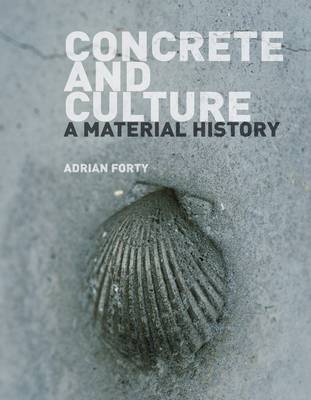[Cover of Adrian Forty's Concrete and Culture. Via. Despite the beautiful picture on the cover, Forty has made a virtue of leaving out the money shots and this book is not a coffee table book - Forty has instead taken most of the photos himself and planned the research for the book to involve immense traveling to Japan, Brazil, Italy etc- oh the joy of being an architectural historian]
Anyone with an interest in concrete or in the discussion of how we understand and use concrete in architectural constructions should check out the book by British architectural historian and Professor at the Bartlett, Adrian Forty. I have been anticipating the publication of Adrian Forty’s book on concrete since I read his 2006 article ‘A Material Without a History’[1]. The article is much quoted for stating the somewhat obviously, that “concrete, let’s face it, is a process not a material.” Following this claim, Forty adds human labor as an ingredient in concrete – as well as cement, aggregate, reinforcement and water. Human labor is obviously an ingredient in other ‘natural’ materials too in order to make stones a cladding, or a tree trunk become a beam etc. For concrete, the work and process about concrete is just crucial and also links to the cultural side of the use of concrete, which is Forty's main objective.
"The book has turned out to be more about architects and architecture than I would have liked. Yet there is a good reason for this, in that architects have paid more attention to the interpretation of concrete as a medium." p11
The research on concrete as a medium (more than a material - which makes sense, I guess, because concrete is the lazy way of describing a group material technologies and practices with cement in common) started around the year 2000. Not an architect, Forty is attracted to the material “because of the inconsistency and contradictoriness of much that was said and written about it, and because of the absence of any coherent account of it as a major component of the modern world.” Forty says, “My work is not so much to increase detailed knowledge of the history of concrete, but rather to develop a general argument about concrete's role in the modern world, as well as within architecture.” [From the Bartlett profile on Forty accessed 26 oct, 2011]
[Lee Marvin as Walker in Point Blank. Via]
In the chapter on Concrete as Natural or Unnatural Forty discusses the changing views on concrete as a natural 'cultured stone' or a more unnatural, artificial building material. The continuous issue of weathering is discussed but also how concrete landscapes are used by film-makers. Though I have not seen John Boorman's 1967 Point Blank starring Lee Marvin, I especially enjoyed Forty's analysis of the use of empty concrete landscapes of Los Angeles taking the place of the classic and symbolic dessert as location. In scenes set against concrete, "men are tested, and sometimes destroyed." (p61)
[Image from the book of the reinforcement placed prior to the floor being poured in a villa by architect Rovelli. From the Hennebique archive. Image link via]
Concrete and photography is the topic of one of the interesting chapters of the book. The architect and scholar Guan Lee of the amazing Grymsdyke Farm was the first I have come across who used this comparison between the process as well as history of photography and concrete. His doctoral dissertation from the Bartlett has not yet been examined. Until then, the chapter written by Forty (also from the Bartlett, remember) offers one aspect of photography and concrete. The early pioneers such as Hennebique and Frank Gilbreth used the photographic medium commercially. Hennebique used photographs in advertisements to sell the systematic and well-proven methods using licensing. The photos had great compositions and were conveying the qualities of the product: its monolithic nature; the precision of the placement of reinforcement (which was invisible but essential features that the client could not see in the end product) – Frank Gilbreth used photography for management - quality control in order to document the construction process on remote construction sites.
Falling apart
One big shame and great nuisance is the fact that most pages have fallen out of the copy of the book I got out of the library. It is ironic that a book about a sturdy building material is not able to stay together. I hope the copy I have ordered for myself may be from another batch, that reprints will solve this major embarrassment of the printer’s. For now, I will have to tie a pretty bow around the library book for other poor readers to deal with as well as trying to make a virtue out of it when I get my own copy.
[1] in [Forty,A. (2006), 'A Material Without a History' in Cohen,J-L., Moeller,G.M. (ed.) Liquid Stone: New Architecture in Concrete, New York: Princeton Architectural Press, (ISBN: 1-56898-570-3), 34-45.] 2006



A neat little review of a fabulous book. I'm afraid to report that our library copy of 'Concrete and Culture' has also started to lose pages. Reaktion Books are an interesting new publisher, but they seem to be cutting corners on production.
ReplyDeleteThat was a great book and also a good source of concrete history up today. I believe the concrete is already part of our world evolution that continuing develop the industry, economics and even our life.
ReplyDeleteConcrete Floor